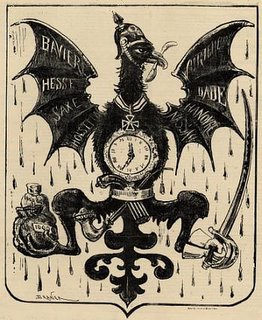
 The female cyclist and caricature
The female cyclist and caricaturein La Parisienne peinte par elle-même
Engraved by Henry Somm
(the caricature in brown ink - is on the same page)
 Drawing by 'Crafty'
Drawing by 'Crafty'"While Haussmann is himself responsible for the "charm" of Paris as we know it today, urbanization of the city depended on the demolition and destruction of many residential properties and traditional quarters. Haussmann's work was therefore often the inspiration for a variety of satirical and political cartoons. The undated caricature shown here is not the first to illustrate and criticize the often chaotic and overwhelming nature of Haussmann's demolition work."
 Lithograph by Alfred Concanen 1857
Lithograph by Alfred Concanen 1857"The Quadrille, introduced in France around 1760, continued to be a popular dance in 19th century Paris. Originally performed in sets of two couples, the quadrille evolved into different forms and variations, many of which were similar to the waltz and the polka."
 Garde champêtre - 'Local Police'
Garde champêtre - 'Local Police'Lithograph by Paul Gavarni 1840 in Le Charivari
"This caricature is a reference to the Bal Chicard,
where party-goers dressed in costume."
 "Construction for the Avenue de l'Opéra officially began in 1854, though it was not until 1873 that it received its name (it was originally called "Avenue Napoléon"). The avenue was initially opened in 1864 and situated between Rue Louis-le-Grand and the Boulevard des Capucines. It was extended, however, in 1867 and again in 1876, and was officially and permanently inaugurated at this latter date. It is now located between the Place du Théâtre-Français and the Place de l'Opéra. Like most of Haussmann's work, the construction of the Avenue de l'Opéra resulted in massive demolition of certain quarters and residences (portrayed here by Jules Férat). By 1876, the total construction costs reached 9.8 million dollars, and 168 homes were destroyed."
"Construction for the Avenue de l'Opéra officially began in 1854, though it was not until 1873 that it received its name (it was originally called "Avenue Napoléon"). The avenue was initially opened in 1864 and situated between Rue Louis-le-Grand and the Boulevard des Capucines. It was extended, however, in 1867 and again in 1876, and was officially and permanently inaugurated at this latter date. It is now located between the Place du Théâtre-Français and the Place de l'Opéra. Like most of Haussmann's work, the construction of the Avenue de l'Opéra resulted in massive demolition of certain quarters and residences (portrayed here by Jules Férat). By 1876, the total construction costs reached 9.8 million dollars, and 168 homes were destroyed." Bah ! Ils seront les premiers à faire une brèche pour me laisser passer -
Bah ! Ils seront les premiers à faire une brèche pour me laisser passer -'Bah! They'll be the first ones to pull thorugh the breach so that I can get through.'
Lithograph by A deVresse 1868 in Le Charivari
 Nouveau Blason Prussien - 'New Prussian Emblem'
Nouveau Blason Prussien - 'New Prussian Emblem'Lithograph by Jules Draner 1870
"Prussian emblem of an eagle with the names of
the newly unified eight German states."
"The project, "Paris, Capital of the 19th century," initiated by the French Studies and Comparative Literature Departments of Brown University, provides a window into the cultural, political and social context of 19th century Parisian culture."
Most of the 825 images available are cartoons/caricatures drawn from the local press but there are some photographs and newspaper images as well. You can load all the images as thumbnails on a single page or search/browse by category. Large jpegs are available.
No comments:
Post a Comment